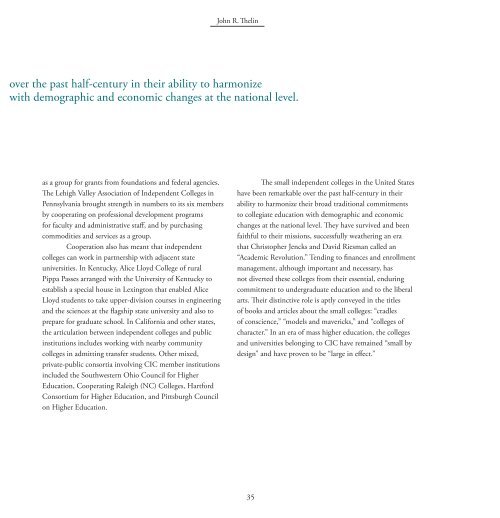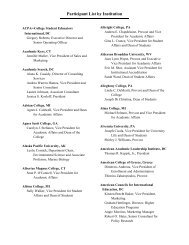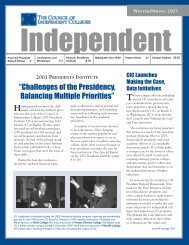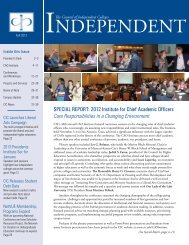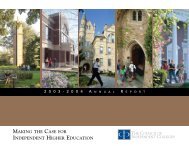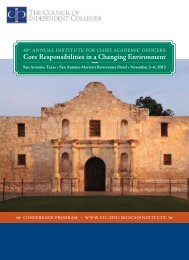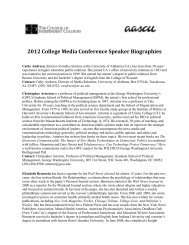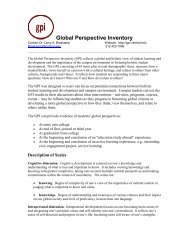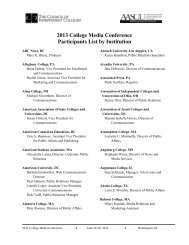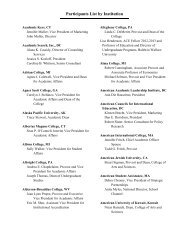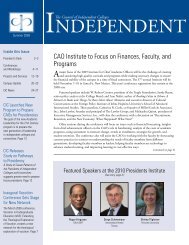Meeting the Challenge: - The Council of Independent Colleges
Meeting the Challenge: - The Council of Independent Colleges
Meeting the Challenge: - The Council of Independent Colleges
Create successful ePaper yourself
Turn your PDF publications into a flip-book with our unique Google optimized e-Paper software.
John R. <strong>The</strong>lin<br />
over <strong>the</strong> past half-century in <strong>the</strong>ir ability to harmonize<br />
with demographic and economic changes at <strong>the</strong> national level.<br />
as a group for grants from foundations and federal agencies.<br />
<strong>The</strong> Lehigh Valley Association <strong>of</strong> <strong>Independent</strong> <strong>Colleges</strong> in<br />
Pennsylvania brought strength in numbers to its six members<br />
by cooperating on pr<strong>of</strong>essional development programs<br />
for faculty and administrative staff, and by purchasing<br />
commodities and services as a group.<br />
Cooperation also has meant that independent<br />
colleges can work in partnership with adjacent state<br />
universities. In Kentucky, Alice Lloyd College <strong>of</strong> rural<br />
Pippa Passes arranged with <strong>the</strong> University <strong>of</strong> Kentucky to<br />
establish a special house in Lexington that enabled Alice<br />
Lloyd students to take upper-division courses in engineering<br />
and <strong>the</strong> sciences at <strong>the</strong> flagship state university and also to<br />
prepare for graduate school. In California and o<strong>the</strong>r states,<br />
<strong>the</strong> articulation between independent colleges and public<br />
institutions includes working with nearby community<br />
colleges in admitting transfer students. O<strong>the</strong>r mixed,<br />
private-public consortia involving CIC member institutions<br />
included <strong>the</strong> Southwestern Ohio <strong>Council</strong> for Higher<br />
Education, Cooperating Raleigh (NC) <strong>Colleges</strong>, Hartford<br />
Consortium for Higher Education, and Pittsburgh <strong>Council</strong><br />
on Higher Education.<br />
<strong>The</strong> small independent colleges in <strong>the</strong> United States<br />
have been remarkable over <strong>the</strong> past half-century in <strong>the</strong>ir<br />
ability to harmonize <strong>the</strong>ir broad traditional commitments<br />
to collegiate education with demographic and economic<br />
changes at <strong>the</strong> national level. <strong>The</strong>y have survived and been<br />
faithful to <strong>the</strong>ir missions, successfully wea<strong>the</strong>ring an era<br />
that Christopher Jencks and David Riesman called an<br />
“Academic Revolution.” Tending to finances and enrollment<br />
management, although important and necessary, has<br />
not diverted <strong>the</strong>se colleges from <strong>the</strong>ir essential, enduring<br />
commitment to undergraduate education and to <strong>the</strong> liberal<br />
arts. <strong>The</strong>ir distinctive role is aptly conveyed in <strong>the</strong> titles<br />
<strong>of</strong> books and articles about <strong>the</strong> small colleges: “cradles<br />
<strong>of</strong> conscience,” “models and mavericks,” and “colleges <strong>of</strong><br />
character.” In an era <strong>of</strong> mass higher education, <strong>the</strong> colleges<br />
and universities belonging to CIC have remained “small by<br />
design” and have proven to be “large in effect.”<br />
35


